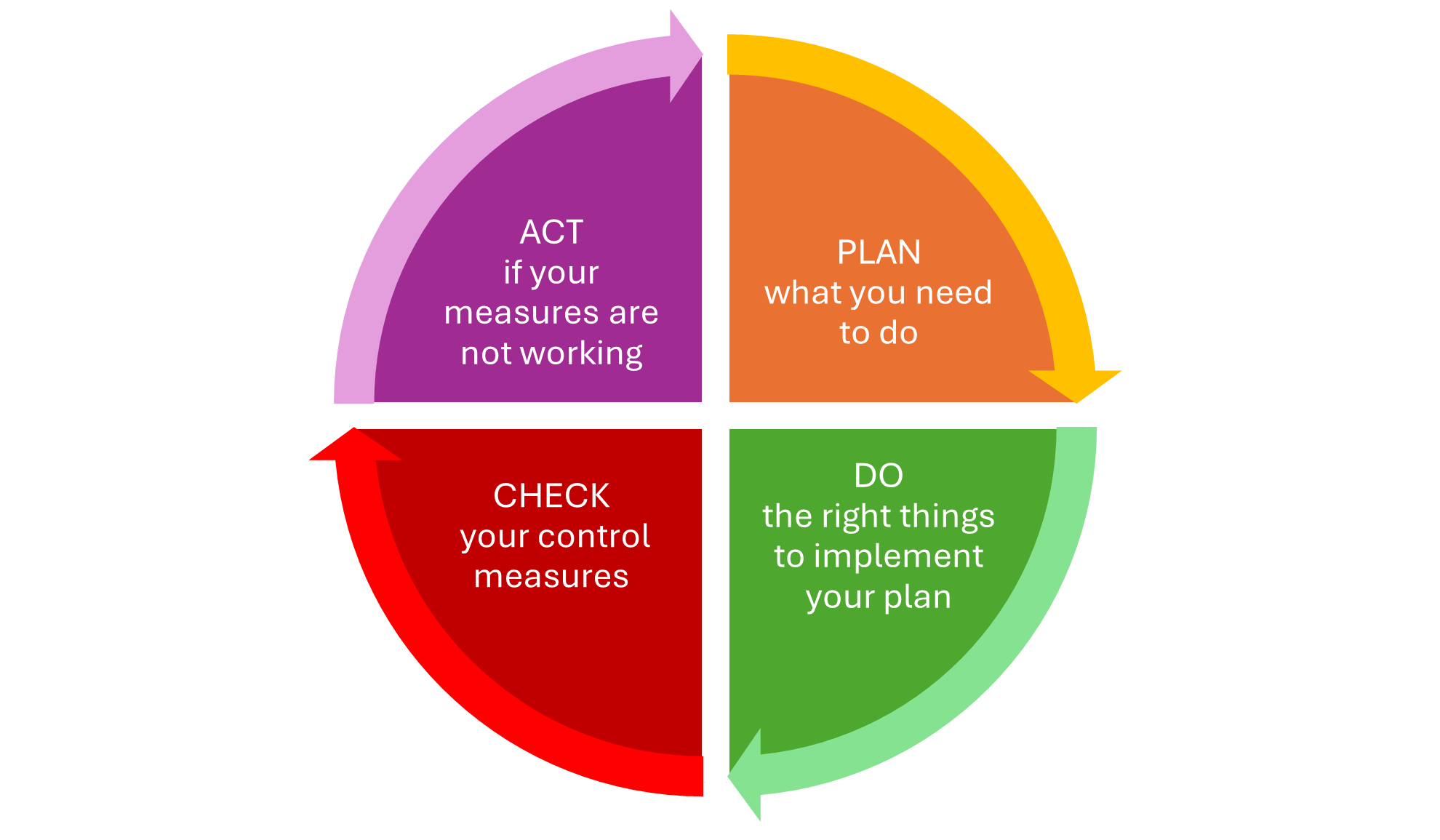We all can react differently to temperature extremes; some tolerate it better than others. During warmer times of the year, workplace temperatures can be problematic and it is incumbent on us all to help manage the problem. Summer is just around the corner and now is a good time to review your arrangements for managing temperatures and workplace heat exhaustion.
The Government and the Health and Safety Executive (HSE) both point out that during working hours the temperature in all indoor workplaces must be reasonable.
There’s no law for minimum or maximum working temperatures, e.g. when it’s too cold or too hot to work. However, guidance suggests a minimum of 16ºC or 13ºC if employees are doing physical work. There’s no guidance for a maximum temperature limit.
Employers must stick to health and safety at work law (The Workplace (Health, Safety and Welfare) Regulations 1992), including:
- Keeping the temperature at a comfortable level
- Providing clean and fresh air
The National Health Service (NHS) explain that heat exhaustion is not usually serious if you can cool down sufficiently within 30 minutes. If it turns into heat stroke however, it needs to be treated as an emergency.
What are the Signs of Heat Exhaustion?
The signs of heat exhaustion include:
- A headache
- Dizziness and confusion
- Loss of appetite and feeling sick
- Excessive sweating and pale, clammy skin
- Cramps in the arms, legs and stomach
- Fast, rapid breathing or pulse
- A high temperature of 38C (100.4F) or above
- Being very thirsty
Things you Can do to Cool Someone Down
If someone has heat exhaustion, follow these 4 steps:
- Move them to a cool place
- Get them to lie down and raise their feet slightly
- Get them to drink plenty of water. Sports or rehydration drinks are OK
- Cool their skin – spray or sponge them with cool water and fan them. Cold packs around the armpits or neck are good, too
Stay with them until they're better, never leave a casualty alone, send others to get additional help if needed. Reassure the casualty and maintain a calm environment. They should start to cool down and feel better within 30 minutes.
What is Heat Stroke?
Heat stroke is a condition caused by your body overheating, usually as a result of prolonged exposure to or physical exertion in high temperatures. This most serious form of heat injury, heat stroke, can occur if your body temperature rises to 104°F (40° C) or higher. The condition is most common in the summer months.
Heat stroke requires emergency treatment. Untreated heat stroke can quickly damage your brain, heart, kidneys and muscles. The damage worsens the longer treatment is delayed, increasing your risk of serious complications or death.
Medically speaking, the British Medical Journal (BMJ) summarise heat stroke as a medical emergency. Clinical features include a core body temperature >40°C and central nervous system dysfunction (e.g., altered level of consciousness ranging from confusion to coma in the context of passive exposure to severe environmental heat (classic heat stroke) or strenuous exercise (exertional heat stroke).Heat stroke is a form of hyperthermia in which the body temperature is elevated dramatically.
The St Johns Ambulance Charity define heat stroke in the following way:
“Heat stroke is caused by a failure of the ‘thermostat’ in the brain which regulates the body’s temperature. This means the body is unable to cool down when it becomes too hot.”
It could be caused by spending too much time in the sun, having a high fever, or from taking non-prescription drugs. It can also occur after heat exhaustion when sweating ceases.
Your priority, as stated previously, is to cool them down as quickly as possible and get them to hospital.
What are the Symptoms of Heat Stroke?
Heat stroke signs and symptoms include:
- High body temperature. A core body temperature of 104 F (40 C) or higher, obtained with a rectal thermometer, is the main sign of heat stroke.
- Altered mental state or behaviour. Confusion, agitation, slurred speech, irritability, delirium, seizures and coma can all result from heat stroke.
- Alteration in sweating. In heat stroke brought on by hot weather, your skin will feel hot and dry to the touch. However, in heat stroke brought on by strenuous exercise, your skin may feel dry or slightly moist.
- Nausea and vomiting. You may feel sick to your stomach or vomit.
- Flushed skin. Your skin may turn red as your body temperature increases.
- Rapid breathing. Your breathing may become rapid and shallow.
- Racing heart rate. Your pulse may significantly increase because heat stress places a tremendous burden on your heart to help cool your body.
- Headache. Your head may throb.
When to Seek Medical Help
If you think a person may be experiencing heat stroke, seek immediate medical help. Call 999 or your local emergency services number. Take immediate action to cool the overheated person while waiting for emergency treatment.
- Get the person into shade or indoors.
- Remove excess clothing.
- Cool the person with whatever means available — put in a cool bath of water or a cool shower, spray with a garden hose, sponge with cool water, fan while misting with cool water, or place ice packs or cold, wet towels on the person's head, neck, armpits and groin.
Heat Exhaustion & Heat Stroke Causes
Heat stroke can occur as a result of:
- Exposure to a hot environment. In a type of heat stroke, called non-exertional (classic) heat stroke, being in a hot environment leads to a rise in core body temperature. This type of heat stroke typically occurs after exposure to hot, humid weather, especially for prolonged periods. It occurs most often in older adults and in people with chronic illness.
- Strenuous activity. Exertional heat stroke is caused by an increase in core body temperature brought on by intense physical activity in hot weather. Anyone exercising or working in hot weather can get exertional heat stroke, but it's most likely to occur if you're not used to high temperatures.
In either type of heat stroke, your condition can be brought on by:
- Wearing excess clothing that prevents sweat from evaporating easily and cooling your body.
- Drinking alcohol, which can affect your body's ability to regulate your temperature.
- Becoming dehydrated by not drinking enough water to replenish fluids lost through sweating.
Risk Factors that May Influence how we Cope with Heat
Anyone can develop heat stroke, but several factors increase your risk:
- Age. Your ability to cope with extreme heat depends on the strength of your central nervous system. In the very young, the central nervous system is not fully developed, and in adults over 65, the central nervous system begins to deteriorate, which makes your body less able to cope with changes in body temperature. Both age groups usually have difficulty remaining hydrated, which also increases risk.
- Exertion in hot weather. Military type training and participating in sports, such as football or long-distance running events, in hot weather are among the situations that can lead to heat stroke.
- Sudden exposure to hot weather. You may be more susceptible to heat-related illness if you're exposed to a sudden increase in temperature, such as during an early-summer heat wave or travel to a hotter climate.
Limit activity for at least several days to allow yourself to acclimatise to the change. However, you may still have an increased risk of heat stroke until you've experienced several weeks of higher temperatures.
- A lack of air conditioning. Fans may make you feel better, but during sustained hot weather, air conditioning is the most effective way to cool down and lower humidity.
- Certain medications. Some medications affect your body's ability to stay hydrated and respond to heat. Be especially careful in hot weather if you take medications that narrow your blood vessels (vasoconstrictors), regulate your blood pressure by blocking adrenaline (beta blockers), rid your body of sodium and water (diuretics), or reduce psychiatric symptoms (antidepressants or antipsychotics).
Stimulants for attention-deficit/hyperactivity disorder (ADHD) and illegal stimulants such as amphetamines and cocaine also make you more vulnerable to heat stroke.
- Certain health conditions. Certain chronic illnesses, such as heart or lung disease, might increase your risk of heat stroke. So can being obese, being sedentary and having a history of previous heat stroke.
Complications
Heat stroke can result in a number of complications, depending on how long the body temperature is high. Severe complications include:
- Vital organ damage. Without a quick response to lower body temperature, heat stroke can cause your brain or other vital organs to swell, possibly resulting in permanent damage.
- Death. Without prompt and adequate treatment, heat stroke can be fatal.
Heat Exhaustion Prevention
Heat stroke is relatively predictable and preventable. Take these steps to prevent heat exhaustion and heat stroke during hot weather:
- Wear loose fitting, lightweight clothing. Wearing excess clothing or clothing that fits tightly won't allow your body to cool properly.
- Protect against sunburn. Sunburn affects your body's ability to cool itself, so protect yourself outdoors with a wide-brimmed hat and sunglasses and use a broad-spectrum sunscreen with a Sun Protection Factor – SPF - of at least 15. Apply sunscreen generously and re-apply every two hours — or more often if you're swimming or sweating.
- Drink plenty of fluids. Staying hydrated will help your body sweat and maintain a normal body temperature.
- Take extra precautions with certain medications. Be on the lookout for heat-related problems if you take medications that can affect your body's ability to stay hydrated and dissipate heat.
- Never leave anyone in a parked car. This is a common cause of heat-related deaths in children. When parked in the sun, the temperature in your car can rise 20 degrees F (more than 11 C) in 10 minutes.
It's not safe to leave a person in a parked car in warm or hot weather, even if the windows are left partially open or the car is in shade. When your car is parked, keep it locked to prevent a child from getting inside.
- Take it easy during the hottest parts of the day. If you can't avoid strenuous activity in hot weather, drink fluids and rest frequently in a cool spot. Try to schedule exercise or physical labour for cooler parts of the day, such as early morning or evening.
- Get acclimatised. Limit time spent working or exercising in heat until you're conditioned to it. People who are not used to hot weather are especially susceptible to heat-related illness. It can take several weeks for your body to adjust to hot weather.
- Be cautious if you're at increased risk. If you take medications or have a condition that increases your risk of heat-related problems, avoid the heat and act quickly if you notice symptoms of overheating. If you participate in a strenuous sporting event or activity in hot weather, make sure there are medical services available in case of a heat emergency.
Need advice and support implementing effective workplace temperature procedures? Get in touch with our team of Health and Safety Consultants today.







